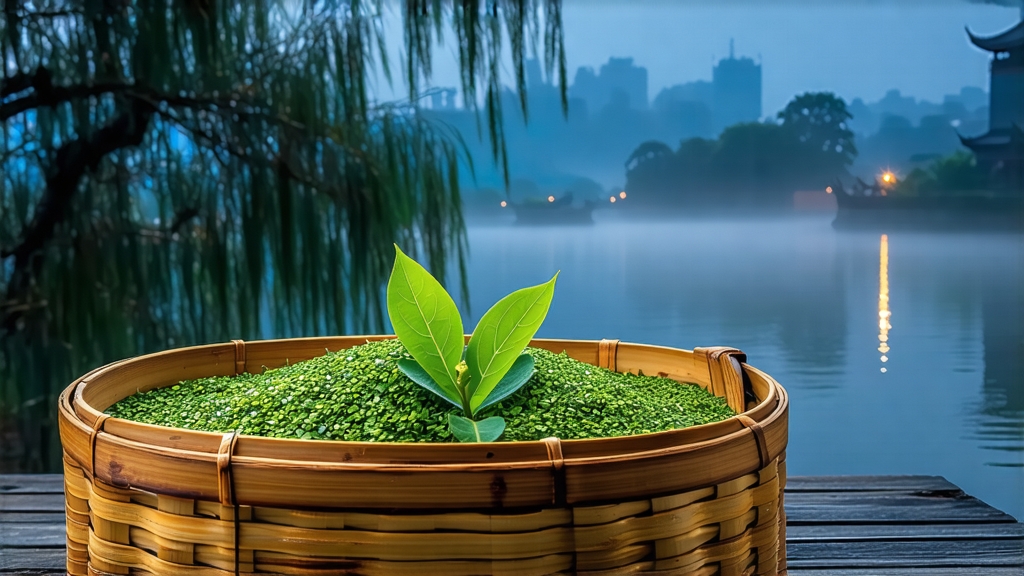
Among the vast family of Chinese green teas, few names travel as gracefully across languages and borders as Longjing. Literally “Dragon-Well,” this flat, jade-green leaf from the hills surrounding Hangzhou’s West Lake has been celebrated in poetry, offered to emperors, and served to world leaders, yet its greatest charm still unfolds in the quiet moment when hot water first kisses the dry blade. To understand Longjing is to listen to a thousand-year conversation between soil, mist, human patience, and fire.
Historical roots
The earliest reliable mention appears in Lu Yu’s eighth-century “Classic of Tea,” which notes that the water from Hangzhou’s Tiger-Running Spring ranks among China’s finest for brewing. By the Song dynasty (960-1279), monks at the temples dotting the lake’s western shore were already shaping leaves on iron woks, but the tea’s mythic aura crystallized during the Qing. Legend claims that the Qianlong Emperor, while visiting the region, personally plucked a handful of shoots in front of Lion Peak Mountain and then hurried back to Beijing, leaving the leaves tucked into his sleeve. Upon his return he discovered they had flattened and exuded an unforgettable fragrance; he immediately decreed that the eighteen bushes he had touched become imperial tribute trees. Those same shrubs still stand today, fenced yet unguarded, their spring harvest auctioned for more than the price of gold per gram.
Terroir and classification
Authentic Longjing can only come from the Xihu (West Lake) protected zone, a crescent of low hills buffered by the lake’s humidity and frequent fog. Within this microclimate six sub-areas are honored as the “core” crus: Lion Peak (Shi Feng), Dragon-Well Village (Longjing Cun), Five Clouds Mountain (Wuyun Shan), Tiger-Running (Hupao), Plum Peak (Meijiawu), and Lingyin. Each site offers minute differences in soil mineral content and diurnal temperature swing, translating into cup profiles that range from bright asparagus and sweet pea to deeper toasted soybean and chestnut. Outside the core zone, the same cultivar—most famously #43 and the heirloom Qunti (group) variety—produces “Zhejiang Longjing,” a pleasant everyday tea that lacks the lingering mineral sweetness locals call “yan yun,” literally “rhyme of rock.”
From bud to leaf: the craft of pan-firing
Longjing is harvested for only about thirty days each year, beginning when the spring thermometer hovers between 10 °C and 20 °C. The standard is one tender bud plus the adjacent leaf, no longer than 2.5 cm, picked before the Qingming festival in early April for the top grade “Mingqian.” Within minutes of plucking, the shoots are spread in thin layers on bamboo trays to wither, shedding grassy volatility while retaining their crystalline jade color.
The decisive act is pan-firing in cast-iron woks heated to roughly 80 °C. A master “tea doctor” uses bare hands to press, tumble, and flick the leaves against the scorching metal, simultaneously halting oxidation and coaxing the signature flat sword shape. Ten minutes of high heat “kills the green,” after which the temperature is lowered to 60 °C for another twenty minutes of repeated stroking, a motion described as “grasping, shaking, rubbing, pressing, and throwing.” One kilo of finished tea demands at least 60,000 gestures. When done correctly the leaf moisture drops to below 7 %, the surface turns matte, and a faint chestnut note appears—evidence of Maillard reactions rarely encountered in other green teas. Cooling on linen allows the internal heat to dissipate before a final low-temperature “refining” fry that locks in fragrance. The entire process must finish the same day the leaf is picked; overnight storage would dull the shimmering color and flatten the aroma.
Reading the dry leaf
Quality cues are visible even before water is boiled. Superior Longjing lies perfectly flat, the tip and leaf forming a symmetrical “flag and spear.” Color should be the tender green of willow shoots in early April, never yellowish or dark forest. When rubbed between fingers the leaf crumbles with a brittle snap, releasing a scent reminiscent of roasted edamame and toasted nori. Broken flakes or excessive powder signal rough handling or machine cutting, both anathema to the purist.
Water, vessel, and temperature
Longjing is delicate; boiling water scorches the amino acids that create sweetness. The classic Hangzhou method calls for spring water brought to 80 °C and then cooled for